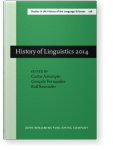Part of
History of Linguistics 2014: Selected papers from the 13th International Conference on the History of the Language Sciences (ICHoLS XIII), Vila Real, Portugal, 25–29 August 2014Edited by Carlos Assunção, Gonçalo Fernandes and Rolf Kemmler
[Studies in the History of the Language Sciences 126] 2016
► pp. 31–42
